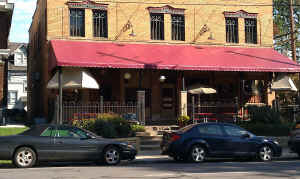|
Home | History | Menu | Contact Us |
|
The building at 1978 Summit Street had been vacant for months. It was laid out in two separate rooms divided by a two-foot-thick brick wall, the rooms joined only by a walkway at the top of the stairs. The restrooms were at the rear of the building behind the kitchen.
During construction, a couple guys approached us outside and asked what kind of place was going in. Upon learning that it was to be a nightclub, they asked if we planned to have music. We hadn’t thought about it, and agreed to give it a try once we opened. The name Ruby Tuesday, of course, came from the song by the Rolling Stones about a seductive, illusive woman. A friend and acquaintance designed the original artwork for the stained glass sign out front and the lamp over the cash register. The walls were adorned with framed sheet music and pictures of women. Ruby Tuesday at the corner of Summit & 19th in Columbus, OH opened without much fanfare in August 1973. All of us were very disappointed that the traffic to the nearby State Fair lent us very few customers. One weeknight, however, a limousine pulled up and parked on the other side of Summit Street. The occupant strode across three lanes of traffic and into Ruby Tuesday. Entering the game room, he approached the jukebox, deposited his quarter, and chose to hear "Jessica." The man who played the song and one solitary game of pool and then left was Greg Allman. The guys that had approached us during construction were hired as an acoustic three-piece country rock group named McGuffey Lane. Members Terry Efaw, Steve Reis, and Bobby McNalley, performing on a small stage on the north wall of the bar room, played their hearts out every Saturday night to a growing crowd of enthusiastic fans. As crowds for McGuffey Lane grew, additional nights were added to their schedule, until they were playing to packed houses 3 nights a week. But fans couldn’t see the band from the game room, and weren’t happy about it. A structural engineer designed the 16-foot opening in a weight-bearing wall, so it had to be constructed with an I-beam overhead. Work began after the bar closed (then at 1:00 a.m.) and the bar was closed a mere day to accomplish the project. The stage was moved into the former game room, and visibility of the performers was greatly improved. McGuffey Lane was only the first in what was to become Ruby Tuesday’s tradition of quality sound entertainment. Bands such as Appalachia, Timberwolf, International Balloon Band, Pedro Hoi, the Alligators, and Urban Sprawl all took their turns at delighting their audiences. Some of the nationally known entertainers who have performed at Ruby Tuesday are Orangelake Drive from Detroit, Alexander Zonjic (the theme from Taxi artist), Grammy-nominee Rare Silk, Buckwheat Zydeco, and Jorma Kaukonen. Ruby Tuesday even showcased Midwest Comedy Tool & Die, an improvisational comedy group, on a weekly basis long before "Whose Line Is It?" came to television. |


